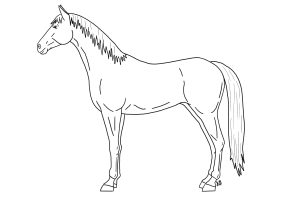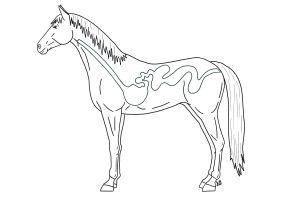35 Digesting Dory: Instructor guide
Sidney Geistfeld; Jennifer Nichols; and Katherine Strohm
Dazzling Digesting Dory
Instructional Guide
Learners will explore the horse digestion system and understand why they need fiber in their diets. The lesson will include a short recording, coloring, videos, interactive games, and two assessments at the end.
Intended Grade Level
This lesson is curated for students grade 3rd-5th.
Students need to know:
-
- The difference between horses and cattle because of the different digestive tracts and mechanisms that occur.
- How to do matching, sequencing, and sorting games
- How to use a electronic device +/- computer mouse
Learning Objectives
- Students will understand the importance of fiber breakdown and how it happens
- Students will be able to explain how food travels through the digestive system of a horse
- Students can categorize the types of fiber horses required
- Students can discuss the surface of horse teeth and explain how they are used to break down food
Lesson Format
The lesson should take 1 hour to complete. Students will need a computer and printer. Students may work in small groups or individually.
- In the beginning, students will be introduced to Dazzling Digestive Dory while coloring their own horse, learn about digestion of the horse (either they can read it or the instructor can read it to them), watch a video of Dory eating, then play a sequencing game (10 minutes).
- (Coloring pages images are included in the Further Exploration section below.)
- Voiceover audio recordings of the text are included throughout the Student Page if students would prefer to have the text read to them.
- Students will go over what horses eat and play a sorting game (5 minutes).
- Additionally, students will read about what fiber is and why is it important with a video (10 minutes).
- Finally, students will read through what happens when horses don’t get enough fiber and play a drag and drop game (10 minutes).
- At the end of the lesson, there will be two assessments for students to take – a drag and drop game and a mini quiz (10 minutes).
- If students want to learn more, they can watch the videos in the further exploration section (5 minutes).
Activities
Link to the Student Page with readings and activities
- Horse Digestion Sequencing Activity: Students are presented with 8 images related to a horse’s digestive tract. They will drag the images and arrange them in the correct sequence of food flowing through the digestive system
- Drag and Drop Horse Foods Activity: Students are shown 6 images of items that may or may not be horse foods. They will use their mouse to drag the pictures into the corresponding categories. If students are unsure what an image is depicting, they can hover over the image for a few seconds and a describing word will pop up.
- Missing Fiber Matching Activity: Students are presented with 4 images relating to fiber deficiencies in horses. They will drag the images on the right over to the left and match them with the corresponding labels.
Common misconceptions and challenge points
- Basic understanding of each part of the digestive system can be confusing – please refer to outside links (YouTube videos attached in the Further Exploration section).
- Dysfunctions:
- Colic: broad term for gastrointestinal pain that could be linked to gas, impaction (fecal/sand), torsion (intestine twisting on itself causes it to lose blood flow and die)
- Ulcers: stomach acid causes damage to the stomach lining causing it to tear and bleed which is extremely painful for the horse
- Abnormal stress behaviors: Horses will develop abnormal behaviors such as cribbing and eating stuff outside of their diet
- Cribbing: horses will place their top incisions (front teeth) on a solid object, arching their neck, pull back, suck air in, and grunt.
- Eating stuff outside of diet: horse who are lacking nutrients and aren’t obtaining 2% of their body weight in forage will try to eat stuff they usually don’t want eat including: wood, dirt/sand, and other horse’s poop
Assessments
Two assessments are included near the end of the lesson.
- Dazzling Digesting Dory Drag and Drop: Students are shown an image of Dory the horse with her digestive system diagram. There are 8 target boxes with 8 terms below. Students should drag the correct term for each part of the digestive tract to the respective target box. This activity will assess the second learning objective: explain how food travels through the digestive system of a horse.
- Dazzling Digesting Dory Quiz: Students are given a short, 5 question quiz with multiple choice questions. They should use their mouse to click the correct answer. After they are done with the question, they can click the blue “check” button to see if they were correct. This activity will assess the first learning objective: understand the importance of fiber breakdown and how it happens, and the final learning objective: discuss the surface of horse teeth and explain how they are used to break down food.
Further Exploration
Coloring page image options:


More helpful videos are on the student page
Other chapters within this textbook may be interesting for students. Some options can be found linked below:

